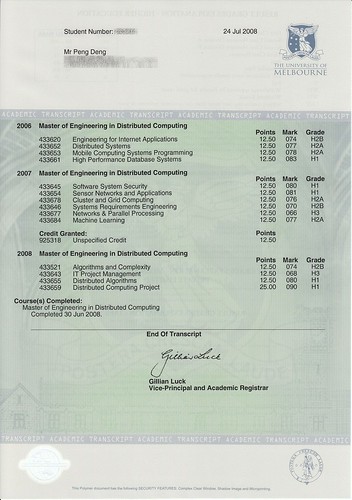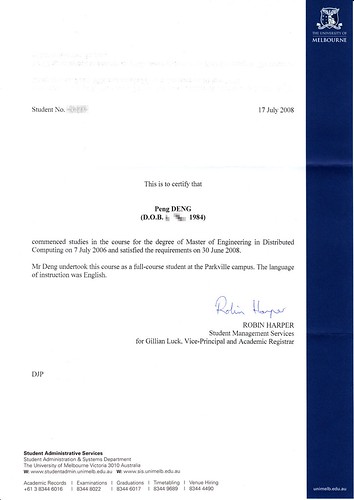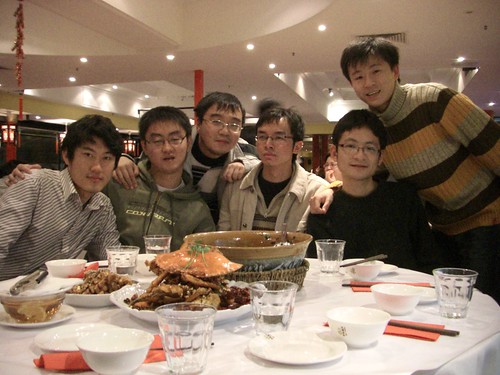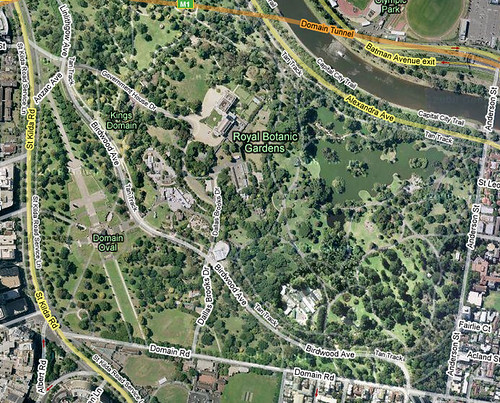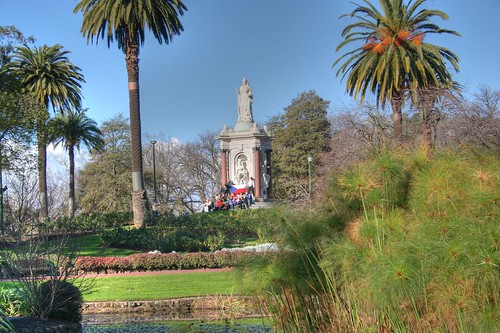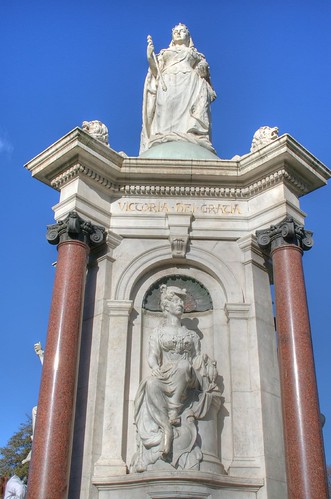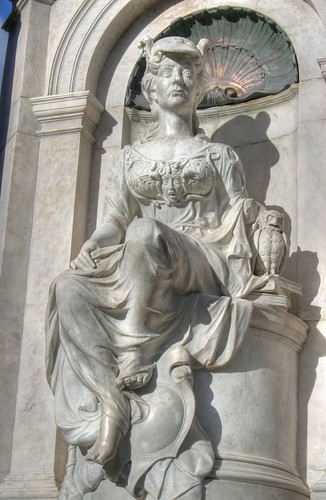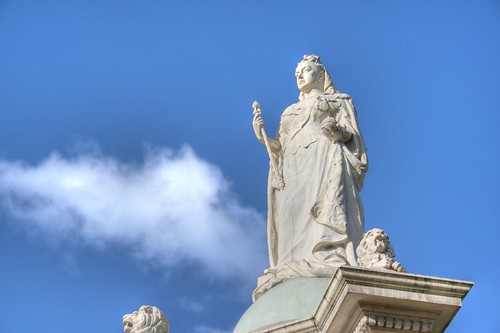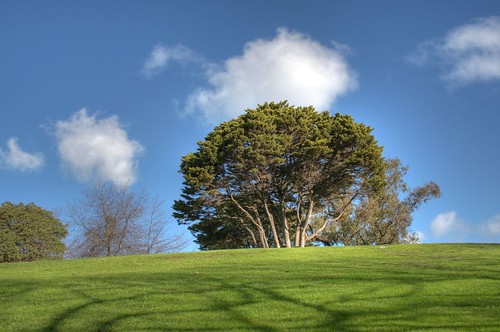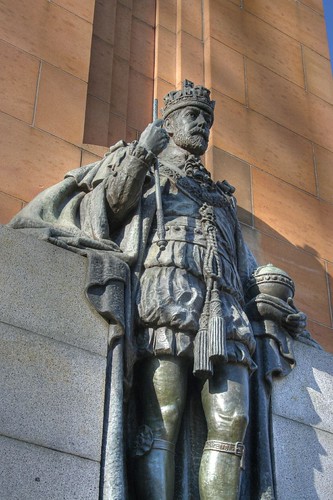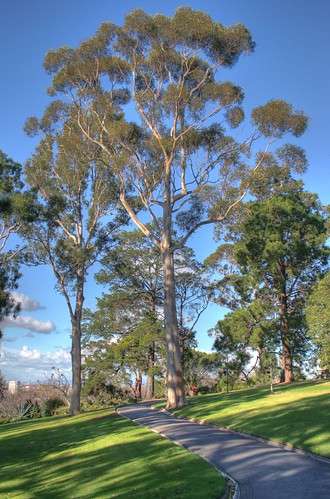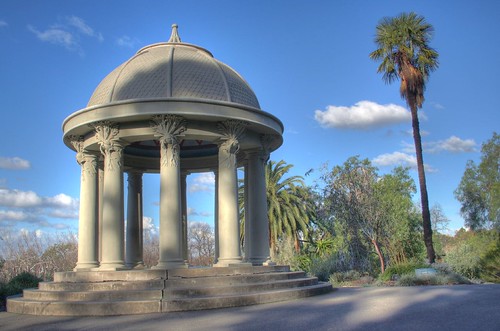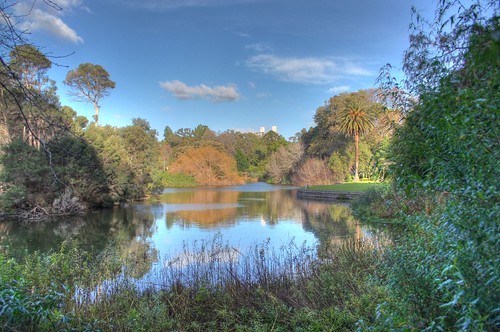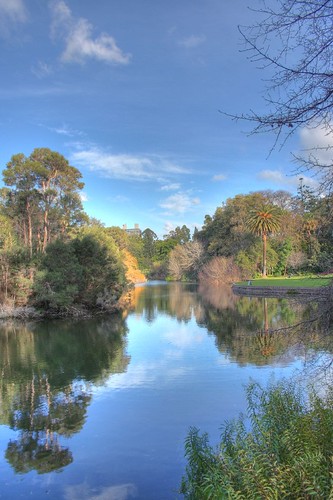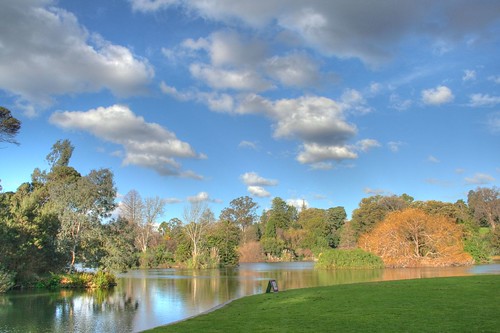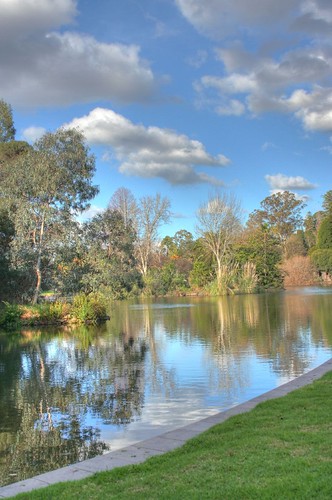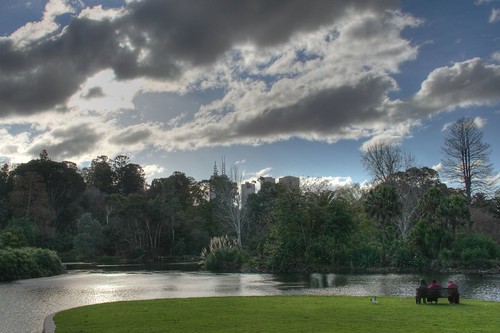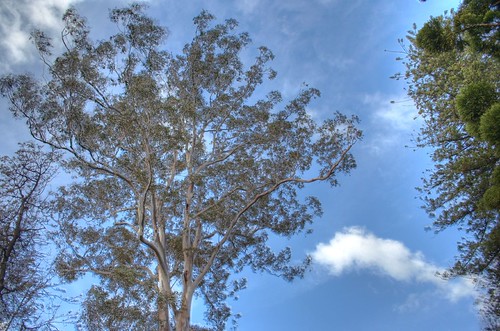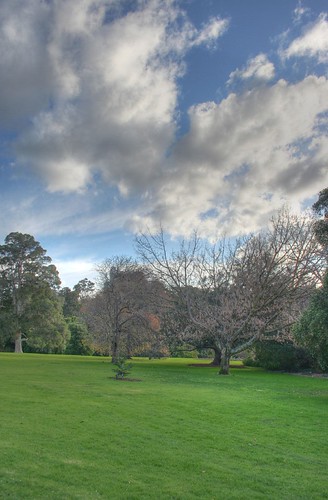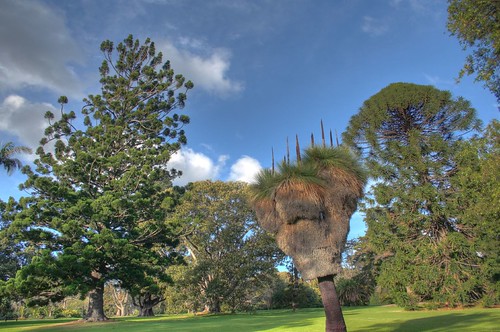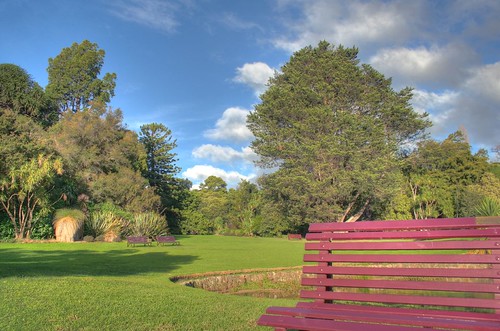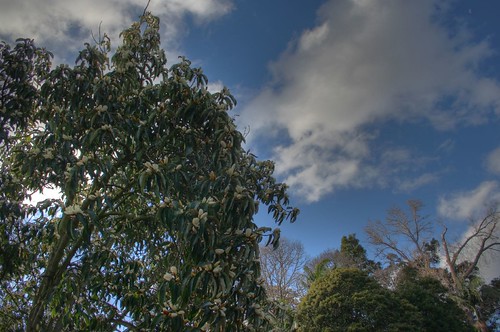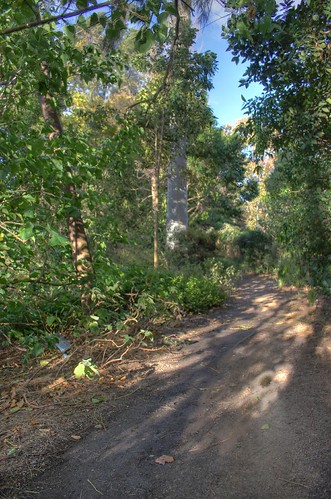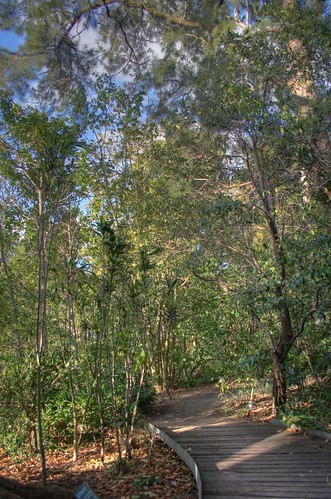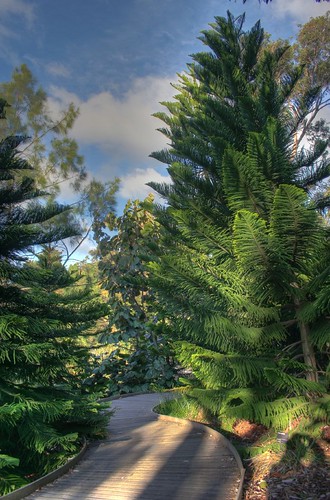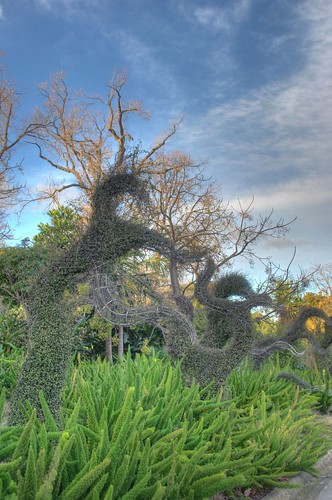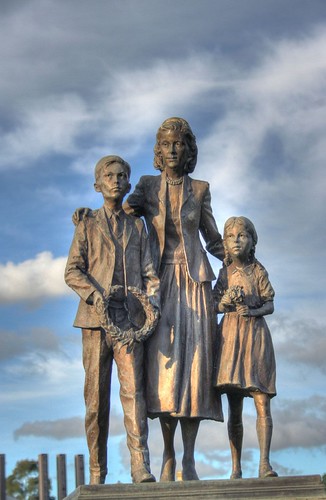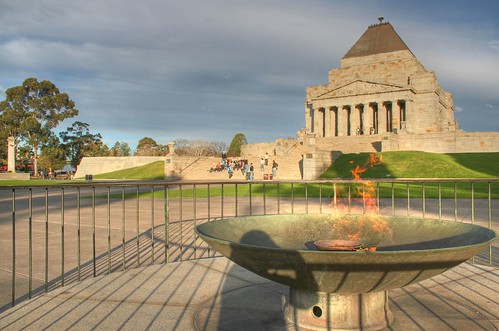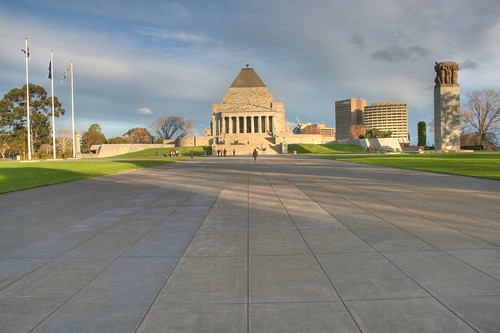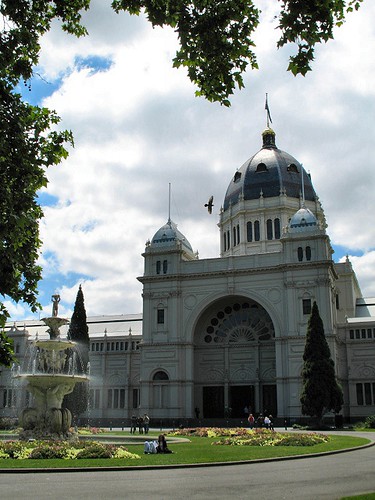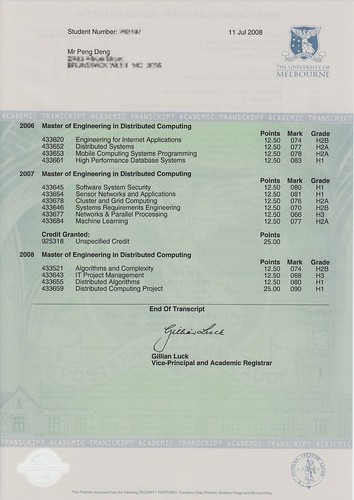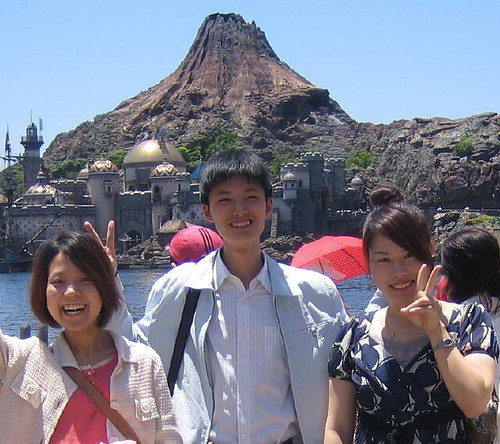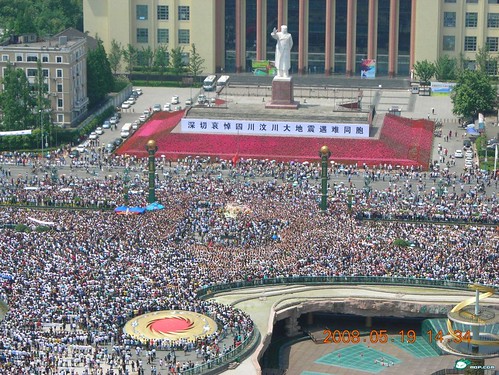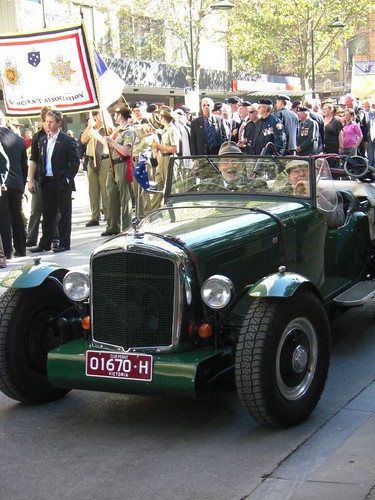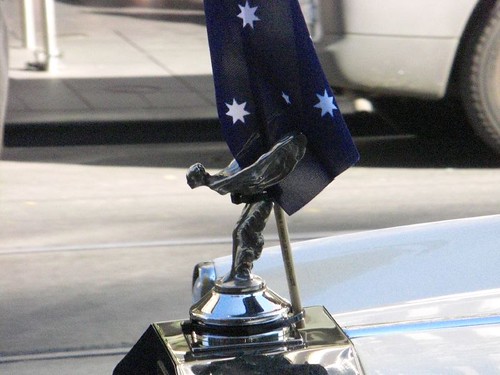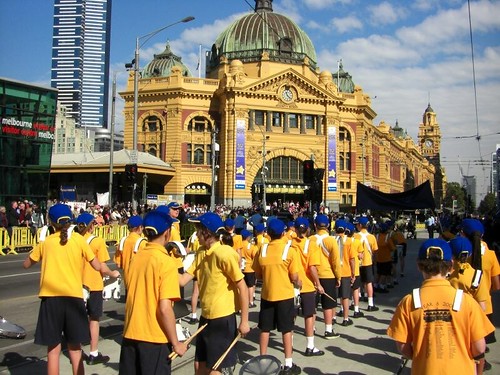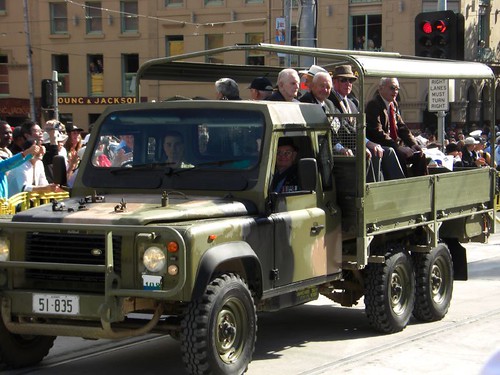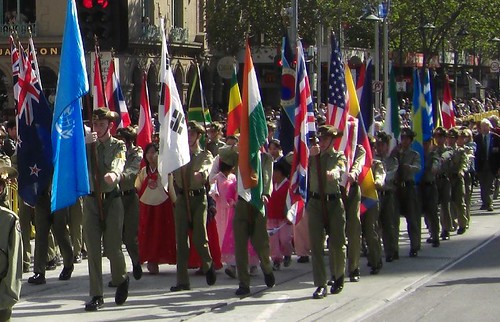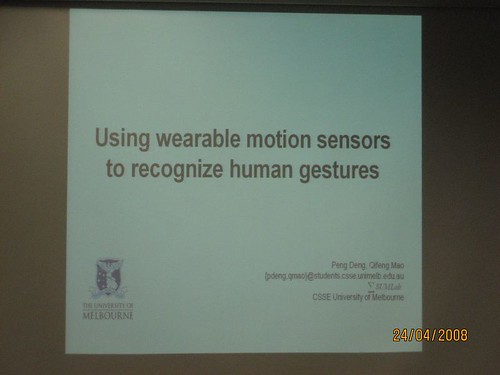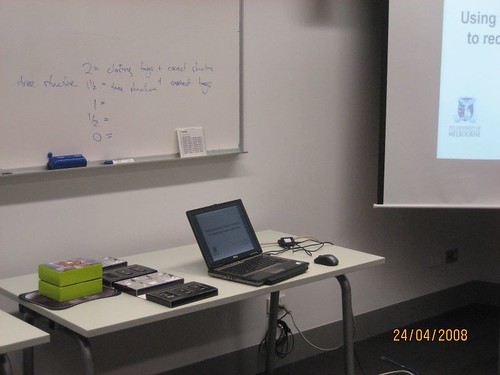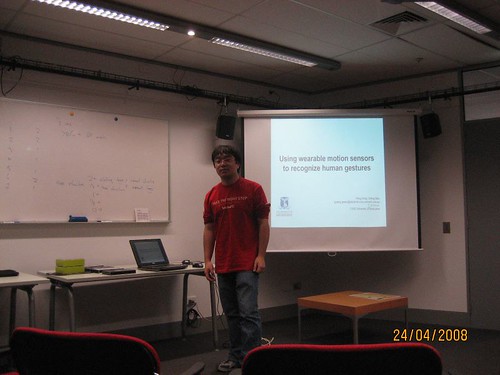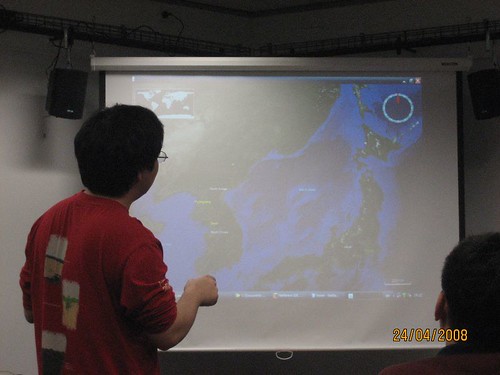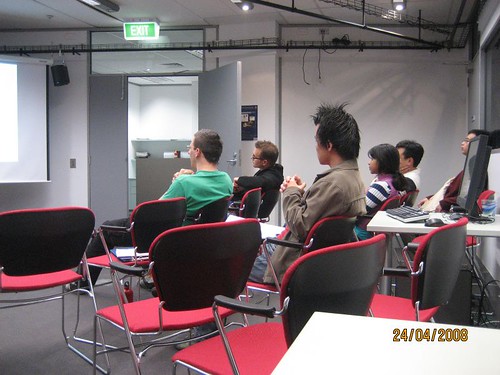皇家植物园就在墨尔本市CBD的边上,地价何止千万。但是墨尔本就是有气魄,不允许任何单位占用此地。

今天怀着不一样的轻松心情,在一次踏上这块美丽的土地。与前几次不同,这回我是把相机三脚架,佳能单反等等装备都配置齐全了的。当然,还有使用了我最新学到的摄影技术。我相信这次的图片绝对震撼!
好!流水账从此开始…
刚从St. Kilda Road上下来,就看到有其他国家的旅行团在这里拍照留念。可能是最近什么世界青年日的参会青年吧~~据说教皇还要来
女皇维多利亚。在下面拍照的时候,一个老大娘走过来,给我说这几个雕像的脸都是她叔叔刻的。还给我讲了一个故事,没听懂…不过最后一个典故听懂了,说女皇站立标准姿势左右脚是有前后顺序的,可是这个雕像弄反了…
刻画的还是相当仔细的,就是脚趾全部没有了…
维多利亚女皇,远看还以为是观音姐姐…
公园一角,上面有小青年在野餐吃巧克力。这个,应该可以作为Windows桌面了吧~~
谁来着,忘了…发动人肉
其实,这才走进皇家植物园。进门就是苍天大树,还记得第一次走进来的时候那种震撼的感觉。国内要看到这种景色,我估计也只有九寨沟了吧
植物与建筑相辅相成。可惜远处有几个大吊车,高楼大厦正在拔地而起,估计未来再看到这么纯净的景色就很难了
公园里面最大的一个湖泊。除了美,还是美,无法用言语来形容
远处是墨尔本CBD最高的几个楼,这片宝地,一定要世代流传才是
墨尔本纯净的空气
其实乌云也挺好看的,很有层次感
风真大,松树都吹弯了~~还有,面前那个是什么树?长的好丑哦!
红蓝绿,传说中光的三原色。其实我不懂,我只是Zhuangbility
这个植物是来自中国西部的,我就觉得很眼熟。光叶木兰,产于四川中部大渡河谷(康定、泸定、石棉)及青衣江(天全、芦山)
模拟的热带雨林小径,还有点味道
儿童植物园,确实有点童话世界的感觉

走出皇家植物园,照例来到烈士纪念堂外面。这个雕塑讲得估计就是牺牲的反法西斯斗士一家的故事吧
宏伟,庄严,肃穆
长明火
远眺烈士纪念堂
下次有时间,将前往Fitzory Garden,里面有库克船长的小屋,还有一个小巧精致的温室,也是相当相当的漂亮…
今天(2008.07.12)决定补充一些文字,添加一些考试的图片。
考试的地点是皇家展览馆,每到期末,这里就被墨尔本大学租下来作为集中考试地点(其实这里本来好像就是属于墨尔本大学的财产,世界文化遗产)。其他学校,比如RMIT就只能到校外的阿尔伯特公园租用室内篮球场考试了。
下面一些图是考试现场,此图是从flickr上面找到的。一次考试,少说也有几千号人在一起,真猛!学生考完之后离场,又是几家欢喜几家愁啊~~~不过我们学校挂科率很低的
结束了最后一门考试,门口撒泡尿留念
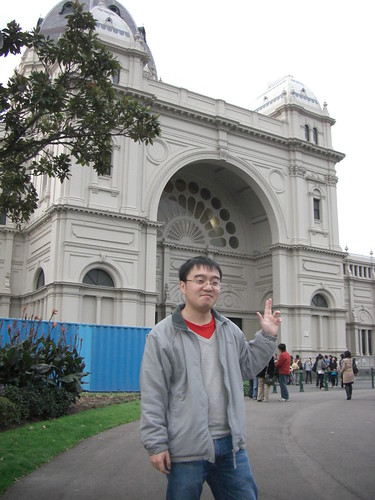

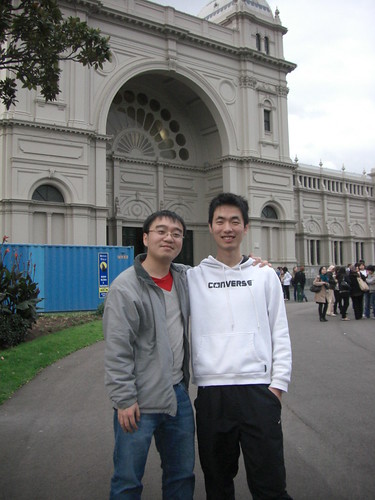
Updated on 11th July 2008
- Algorithms and Complexity 074 H2B (I should spend more time on this, it is simple to get 80s but I did not
 )
)
- IT Project Management 068 H3 (It sucks! I hate open book exam and people who do not want to contribute in assignments)
- Distributed Algorithms 080 H1 (I think I can get 85
 . I asked my friend, it seems 80 is not low in this subject )
. I asked my friend, it seems 80 is not low in this subject )
- Distributed Computing Project 090 H1 (I am proud of what I did. But it really not as good as the mark
 . Thank you, supervisor)
. Thank you, supervisor)
今天早上,在再一次通读全文,修改部分语法、表达之后,讲毕业设计报告提交给了导师。接下来面对的就是紧张的考试了~~
依然按照我的风格,文档代码全部开源,除非特别说明所有资源全部使用GPL v3发放,请遵守该License的规定。
ABSTRACT: We developed a gesture based human computer interaction interface. Wireless sensor node is used to capture human body acceleration data. To segment received acceleration data stream, we developed an algorithm based on sliding window and standard deviation. To recognize gesture, Hidden Markov Model (HMM) which is a machine learning algorithm is used. Series prototype applications are built to demonstrate possible gesture based applications in future. We conducted several experiments as well. Finally, we got highest 96% accuracy and lowest 17% accuracy.
KEYWORDS: body sensor network, wireless sensor network, data stream processing, hidden markov model, machine learning, gesture recognition, human-computer interface
(非IE用户可能不能正常浏览)
程序源代码将在考试之后放到网上,谢谢。
同时,将本科毕业设计报告一并开源。巧合的是,本科毕业设计完成时间6月10日,研究生毕业设计完成时间6月11日。大家看看两年了,是否有进步。
(非IE用户可能不能正常浏览)
程序源代码将在考试之后放到网上,谢谢。
在陶哥的关照下,今天有幸和他一起来到Sun Microsystem维多利亚州分部做了一个关于Sun SPOT的演讲。澳大利亚这边的Sun工作人员并不是十分了解SPOT技术,而他们又渴望知道。所以就邀请了我和陶峙崎一起做了一个简单的汇报。
今天的演讲一切顺利!我们准备了很多很多演示程序。稍有点可惜的是今天演讲时间大大超出预期,最有技术含量的项目没有得到很好的展示。不过,我今天很高兴,很高兴 🙂 还有一点失误的是,没照相。只好把今天的幻灯片共享出来供大家解馋了~~~~
大学同学刘犁寒,都江堰人是也。5.07从东瀛回国,512当日,在家蒙头大睡。床摇,依稀梦回日本。慢悠悠起床,踏着棉花下楼,刚走到门口,看见对门六层大楼瞬间倾覆,才知大事不好。终于躲进安全地带。
几日不见音信,今日终于在网上出现,大喜。还好,没事就好~~~
刘犁寒和他的日本同事在东京迪士尼
希望其他的同学,朋友都好!
2008年5月19日下午2点28分,成都天府广场
全国人民
澳新军团日(ANZAC Day)是纪念1915年4月25日,在加里波利之战牺牲的澳大利亚和新西兰联合军团(简称澳新军团)将士的日子。澳新军团日在澳大利亚和新西兰现均被定为公众假日,以缅怀他们为国牺牲的勇敢精神。澳新军团日是两国最重要的节日之一。
维基百科编者 (2008). 澳新军团日. Wikipedia, . Retrieved 04:46, 4月 25, 2008 from http://zh.wikipedia.org/w/index.php?title=%E6%BE%B3%E6%96%B0%E5%86%9B%E5%9B%A2%E6%97%A5&oldid=6691637.
现在Anzac Day更像是老兵的节日。对于我来说,今天也就是找个理由出去耍一下。
老兵们排队集合
别小看这些老爷车,来头都不小的
上面坐的人更是了不得的
我想澳大利亚政府这样的安排,应该是让年轻一代接受爱国主义教育吧。
中学生鼓号队正在Flinder Street Station下面等待入场。看到他们,就想起了我小学时候,也是鼓号队的,也曾经参加各种什么什么活动,呵呵。
当年的军车?
这支部队以前驻扎日本?没听说过呢。
韩战的部队,这个我就不鼓掌了。对于韩战,金胖子他爸责任最大,剩下双方都是受害者。
多少川军血撒异国,以巨大的牺牲换来了同联合国军作战的胜利。但是转眼看看今天的朝鲜,怎么看怎么不爽
还是希望世界和平,下面走来的是联合国维和部队。蓝色的贝雷帽,很好看。
好像是二次世界大战盟军特种部队的车
这个视频里面的是澳大利亚特种部队的车,好像比刚才的现代一点。还可以听到我旁边一个妇女对着一大群老头子欢呼"Well done, boys~~~" 太搞笑了。
4月24号,奥运圣火来到澳洲首都堪培拉。本来说要去保卫圣火的,但是因为我的演讲安排在了24号,所以只能忍痛把已经买好的车票退了。
今天的演讲内容主要是我还在进行的毕业设计。演讲对象是Department of Infomation System的Interaction Design Lab。因为明天是ANZAC Day所以,来听的人并不多。但是我自认为,今天的演讲还是不错的。本周两个作业要交,再加上这个讲座,很忙,幻灯片是今天早上才做完的。几乎就是直接上台演讲~~~~
今天演讲的题目
演讲设备 一个笔记本,4个Sun SPOT
今天特地穿上红衣,胸前一段话中有China。以表示我对奥运的支持
第二个演示程序,用两个SPOTs控制NASA World Wind。 效果就是一个字,炫
今天听的人不是很多,呵呵。但反响还算热烈
今天早上的奥运圣火传递还是相当顺利的。虽然蓝衣护跑队员只有两名,但是澳大利亚联邦警察这次还是很称职,很好的保护了火炬和火炬手的安全。
据媒体报道,几天前往堪培拉的中国人超过2万,ZD不足2000。当火炬走到澳大利亚战争纪念馆的时候,3名ZD翻过栏杆想挡在前进路线上。大约50名中国学生跟随而至,并用红旗将他们掩盖。呵呵呵,好样的!今天的活动,留学生兄弟姐妹们都表现的很好,没有暴力事件发生,大家都用合理的方式表达了对奥运的支持,对ZD的反对。
摘录一些Yahoo Australia的新闻图片:

圣火到来的堪培拉,今夜为奥运狂欢

两名护跑队员+一群AFP

同学们都是熬夜过去的,很辛苦

首都一半的警察都在这里,对于暴力的ZD,一定要当心啊

对于ZD,就是要用有力的声音压制住他们
In the morning of April 6, looking at the snowflakes falling outside the window, I could not but wonder what the torch relay would be like.
About 8 hours later, when the torch finally struggled through the route, Olympic gold medalist Dame Kelly Holmes ran up to light the Olympic cauldron at the O2 dome, and 4,000 spectators cheered, obviously with a sense of relief.

This day will be remembered, as Beijing met London with splashes and sparkles. It was an encounter between China, the first developing country to host the Olympics, and Britain, the first western country to greet the 2008 torch.
On the bus to the airport, I was with some young girls from the Beijing team, including an Olympic gold medalist, Miss Qiao.
They were convinced that the people here were against them. One girl remarked she couldn’t believe this land nourished Shakespeare and Dickens.
Another asked: where is the "gentlemenship"? I used all my knowledge to argue for London, and looking into their watery eyes, I knew I was not succeeding. I can’t blame them.
They were running between vehicles for the whole day, noses red and hands cold, trying to service the torch bearers.
They had only about three hours of sleep the previous night and some were having lunch sandwiches just now.
Worse still, they had to endure repeated violent attacks on the torch throughout the relay. I was fortunate to sit at the rear of the bus and saw smiling faces of Londoners who came out in the tens of thousands, old people waving and young performers dancing, braving the cold weather.
In the darkness of a London night, waving the chartered plane goodbye, I had a feeling the plane was heavier than when it landed. The torch will carry on, and the journey will educate the more than a billion Chinese people about the world, and the world about China.
A young friend in China wrote to me after watching the event on the BBC: "I felt so many things all at once – sadness, anger and confusion." It must have dawned on many like him that simply a sincere heart was not enough to ensure China’s smooth integration with the world.
The wall that stands in China’s way to the world is thick. In China, what’s hot at this moment on the internet, which has 200 million users there, is not only the attempts to snatch the torch but also some moving images of Jin Jing, a slim young girl, a Paralympic athlete in a wheelchair, helped by a blind athlete. She held the torch with both arms to her chest as violent "protesters" tried repeatedly to grab it from her during the Paris relay.
There is especially infuriated criticism of some of the misreporting of China in recent weeks, such as crafting photos or even using photos from other countries to prove a crackdown. On the other side of the wall, the story is different.
Standing in the middle, I am concerned that mutual perceptions between the people of China and the West are quickly drifting in opposite directions. I cannot help asking why, when it comes to China, the generalised accusations can easily be accepted without people questioning what exactly and specifically they mean; why any story or figures can stay on the news for days without factual support.
Even my own participation in the torch relay had been the subject of continuous speculation. I remember a local friend said, "We all like to read media stories. Only when it comes to ourselves do we know they can’t all be true."
Of those who protested loudly, many probably have not seen Tibet. For the Chinese people, Tibet is a loved land and information about it is ample. Four million tourists visit Tibet every year. The past five years saw the income of farmers and herdsmen increasing by 83.3 per cent. In 2006 there were more than 1,000 schools, with 500,000 students.
In this Autonomous Region, where 92 per cent of the population is Tibetan, there are 1,780 temples, or one for every 1,600 people – which is more than in England, where there is one church for every 3,125 people.
There may be complicated problems of religion mixing with politics, but people are well-fed, well-clothed and well-housed. That has been the main objective of China for centuries. Tibet may not grow into an industrial place like the eastern cities in China, but it will move on like other parts of China.
I personally experienced China’s transition to opening up, from small steps to bigger strides. I remain a consistent and firm supporter of opening up. The latest events have led the younger generation of Chinese, those born since the 1980s, who grew up in a more prosperous, better-educated and freer China, to begin a collective rethinking about the West.
My daughter, who loves Western culture, must have used the word "why" dozens of times in our long online chat. Her frustration could be felt between the lines. Many who had romantic views about the West are very disappointed at the media’s attempt to demonise China.
We all know demonisation feeds a counter-reaction. I do pray from the bottom of my heart that the younger generation of Chinese will not be totally disillusioned about the West, which remains an important partner in our ongoing reform.
Many complain about China not allowing enough access to the media. In China, the view is that the Western media needs to make an effort to earn respect. Coming to China to report bad stories may not be welcomed but would not be stopped, as China is committed to opening up.
China is far from perfect and it is trying to address the many problems that do exist. It would be helpful to the credibility of the Western media if the issues they care and write about are of today’s China, not of the long-gone past.
In my one year in the UK, I have realized that there is a lot more media coverage about China than when I was a student here in the mid-1980s, and most of it is quite close to the real life of China, good or bad.
China is also in an era of information explosion. I am sure that more and more people in the West will be able to cross the language and cultural barriers and find out more about the real China. The world has waited for China to join it. Now China has to have the patience to wait for the world to understand China.
Fu Ying is the Chinese Ambassador to London
Digest from http://www.telegraph.co.uk/opinion/main.jhtml?xml=/opinion/2008/04/12/do1210.xml

